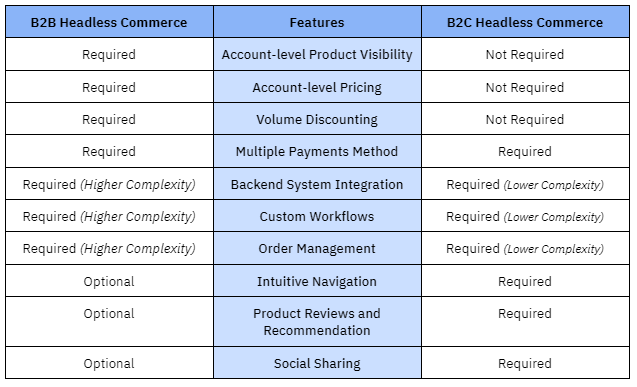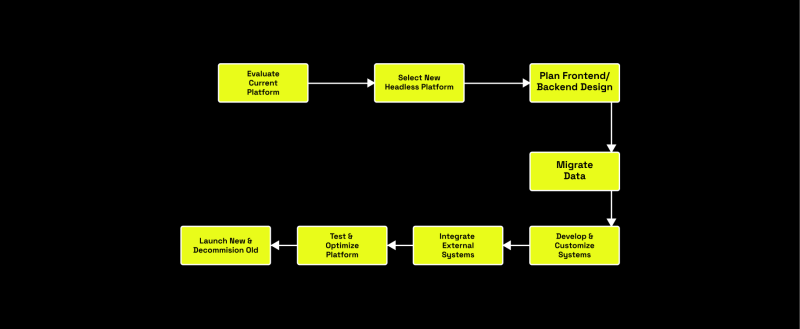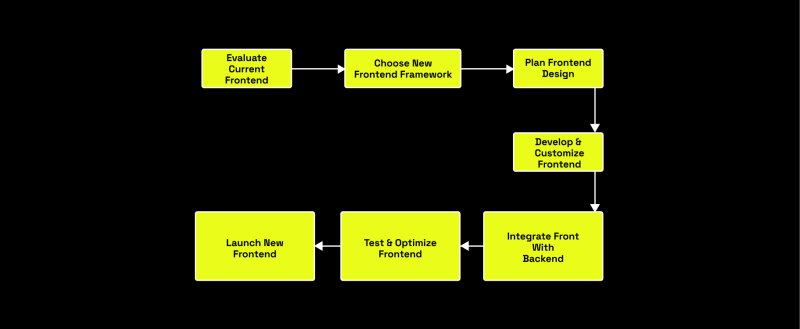/ Articles
B2B Headless Commerce: Essential Features, Challenges & Implementation
Aakanksha Sharma
Content Marketer
- DATE PUBLISHED (17/4/2023)
- READ TIME (5MIN)
In the rapidly evolving business landscape, eCommerce has become vital for any company's success. The shift towards headless commerce, which decouples the frontend presentation layer from the back-end eCommerce functionality, has become increasingly significant in B2B.
B2B e-commerce continues to be the fastest-growing channel, with manufacturers experiencing a substantial 17.8% growth in 2021, reaching $1.63 trillion in sales, up from $1.39 trillion1. In this article, we'll dive into:
What is B2B headless commerce?
When Is Headless Commerce The Right Choice For B2B?
B2B Headless Commerce Vs. B2C Headless Commerce
What are the advantages of B2B Headless Commerce?
What are the challenges of B2B Headless Commerce?
Implementation Guide for B2B Headless Commerce: Full Replatforming Vs. Frontend Centric Migration
What Is B2B Headless Commerce?
B2B headless commerce is a cutting-edge eCommerce approach specifically catering to the needs of businesses serving other businesses. It decouples the presentation layer from the backend eCommerce functionality, allowing companies to craft tailored and engaging customer experiences across multiple channels and devices.
In contrast to traditional monolithic systems, where frontend and backend are closely interwoven, B2B headless commerce offers flexibility and customization that better serve the unique demands of B2B transactions. By utilizing a common API for backend functionality while employing various frontend frameworks, this architecture enables scalability and seamless customer experiences.
When is Headless Commerce the Right Choice for B2B?
Headless commerce becomes an ideal choice for B2B businesses when they aim to create a consistent customer experience across multiple channels and devices. For instance, a customer might begin browsing a product on their desktop, continue on their mobile device, and finalize the purchase on a tablet.
Headless commerce ensures a seamless experience, regardless of the device or channel employed.
Another key factor that makes headless commerce attractive to B2B businesses is the ease of integration with other systems and applications. Companies can swiftly add new functionalities or features to their eCommerce platform without rebuilding the entire system.
For example, integrating an eCommerce platform with a CRM system becomes hassle-free, enabling personalized product recommendations based on customers' purchase histories.
In short, if you are looking to upscale your existing eCommerce for unparalleled flexibility, customization, and scalability, b2b headless commerce is the preferred choice.
You can deliver unique and engaging customer experiences while effortlessly integrating with other systems and applications.
B2B Headless Commerce Vs. B2C Headless Commerce
When it comes to eCommerce, there are two primary models: business-to-business (B2B) and business-to-consumer (B2C). While these two models may seem similar at first glance, they differ significantly in functionality and features when implemented using headless commerce architecture.

Features of B2B Headless Commerce
One of the key differences between B2B and B2C headless commerce is the complexity of features required for B2B transactions. B2B headless commerce requires more complex features such as order management, pricing, and quotes, which are not typically required in B2C headless commerce.
For example, in a B2B transaction, a buyer may need to place an order for a large number of items, each with a unique price based on volume discounts or negotiated pricing. This requires a sophisticated pricing engine that can handle complex pricing structures.
Additionally, B2B transactions often involve custom quotes, which require a quoting engine that can generate accurate quotes based on specific customer requirements.
B2B headless commerce solutions need to provide additional features such as custom workflows, inventory management, and integration with various backend systems, including CRMs and ERPs. These features are critical for B2B transactions, as they help streamline the buying process, reduce errors, and improve overall efficiency.
Features of B2C Headless Commerce
While B2C headless commerce may not require the same level of complexity as B2B headless commerce, it still requires a range of features to provide a seamless shopping experience for consumers.
For example, B2C headless commerce sites need to provide intuitive navigation, easy-to-use search functionality, and a streamlined checkout process. Additionally, B2C headless commerce sites need to provide a range of payment options, including credit cards, PayPal, and other digital payment methods.
B2C headless commerce sites also need to provide features such as product reviews, product recommendations, and social sharing functionality to help consumers make informed purchasing decisions and share their experiences with others.
While both B2B and B2C headless commerce models share some similarities, they differ significantly in terms of functionality and features. By understanding the unique requirements of each model, businesses can choose the right headless commerce solution to meet their specific needs and drive growth.
The Advantages of B2B Headless Commerce
B2B headless commerce has transformed the eCommerce landscape, offering numerous advantages over conventional platforms. Here are the key benefits:
1. Increased flexibility and scalability
Traditional eCommerce platforms can be restrictive, limiting growth and customization. However, headless commerce enables businesses to scale their operations quickly and tailor their online stores to their unique needs.
For example, a B2B company with seasonal product offerings can quickly adapt its frontend design and content to reflect inventory changes without affecting back-end functionality.
2. Greater customization capabilities
Headless commerce provides more control over the frontend presentation layer, empowering businesses to craft personalized shopping experiences for their customers. A B2B company can customize its product catalog display based on a customer's industry, purchase history, or specific requirements, fostering customer satisfaction and loyalty.
3. Improved API integrations
Headless commerce simplifies connections with other software applications and services, streamlining operations and enhancing efficiency. For instance, a B2B company can seamlessly integrate its eCommerce platform with a CRM system to track customer interactions and provide personalized product recommendations.
4. Optimized performance and faster loading speeds
Slow loading times on traditional platforms can frustrate customers and result in lost sales. With headless commerce, businesses can optimize their online stores for rapid loading, improving customer experience and boosting sales. For example, a B2B company with high-quality product images and videos can optimize its frontend for faster load times without compromising visual appeal.
5. Improved customer experience and engagement
Headless commerce allows businesses to create tailored shopping experiences that captivate customers and encourage repeat visits. Enhanced engagement leads to greater customer satisfaction, loyalty, and, ultimately, increased revenue.
For instance, a B2B company can offer personalized pricing or exclusive promotions based on a customer's previous purchases or account status.
Headless commerce is also crucial for businesses catering to a global customer base, as it enables localization and language support across different regions and countries. This feature simplifies international expansion and helps businesses reach a wider audience.
B2B headless commerce boasts several advantages over traditional platforms, making it indispensable for businesses aiming to stay competitive in the eCommerce world. Its flexibility, customization capabilities, improved API integrations, optimized performance, and enhanced customer experience make it a game-changer for B2B companies.
The Challenges of b2b Headless Commerce
While B2B headless commerce has gained popularity for its ability to deliver seamless and personalized user experiences, businesses should be aware of the challenges they may encounter when implementing this solution.
Integration Challenges
A significant challenge in adopting headless commerce is the integration process. Separating the frontend and backend necessitates the integration of various frontend frameworks and backend systems. This complex, time-consuming task requires specialized technical expertise.
To ensure seamless user experiences, businesses must integrate all systems flawlessly. This demands a deep understanding of different systems and frameworks, which can be challenging for companies lacking the necessary technical expertise.
Cost Challenges
Despite their numerous advantages, Headless commerce solutions can be expensive to implement and maintain. The costs might deter smaller B2B businesses with limited budgets from investing in such a solution.
Before committing to headless commerce, businesses should evaluate the costs against the potential benefits. While the initial investment might be substantial, the long-term benefits could justify the expense.
Customization Challenges
Headless commerce's frontend-backend separation grants businesses greater control over frontend user experiences. However, this also means companies must invest in frontend customization to meet their specific requirements.
Customizing the frontend can be a resource-intensive process that demands specialized technical skills. Therefore, businesses should carefully assess their customization needs before adopting a headless commerce solution.
Implementing b2b headless commerce: Replatforming Vs. Frontend-centric Migration
When it comes to implementing B2B headless commerce, businesses have two main options:
re-platforming,
frontend-centric migration.
The best choice depends on the company's existing systems, budget, and long-term goals. This practical insight will help you understand the differences between these approaches and make the right decision for your business.
Replatforming
Replatforming involves migrating your entire eCommerce solution to a new headless commerce platform, including both frontend and backend systems. This approach suits businesses that want to upgrade their full tech stack, require significant customization, or have outdated systems that cannot support headless commerce.

Pros:
A fresh start: Replatforming allows you to build a new, modern eCommerce solution from scratch tailored to your business needs.
Enhanced functionality: By choosing a headless commerce platform designed explicitly for B2B, you can benefit from advanced features like account-level customization and complex order management.
Streamlined operations: A complete migration to a new platform can help eliminate legacy system issues and improve operational efficiency.
Cons:
Costly: Replatforming can be expensive due to the need for new software licenses, development resources, and data migration.
Time-consuming: A complete migration requires significant time and effort, which may affect your business operations during the transition.
Frontend-centric Migration
Frontend-centric migration involves updating the frontend layer of your eCommerce solution and integrating it with your existing backend systems through APIs. This approach is ideal for businesses with robust backend infrastructure and wants to focus on enhancing customer experience without changing the entire system.

Pros:
Lower costs: This approach requires fewer resources, as you only need to update the frontend and establish API connections.
Faster implementation: Updating the frontend and integrating APIs is quicker than a complete re-platforming, minimizing disruption to your operations.
Leverage existing investments: Frontend-centric migration allows you to use your existing backend infrastructure, preserving your previous investments.
Cons:
Limited flexibility: Your frontend improvements may be constrained by the limitations of your existing backend systems.
Integration challenges: Connecting your new frontend to legacy backend systems may require custom development and could lead to potential compatibility issues.
When deciding between re-platforming and frontend-centric migration for B2B headless commerce implementation, consider your business's specific needs, budget, and long-term goals.
Replatforming offers a complete overhaul and enhanced functionality but comes at a higher cost and requires more time. In contrast, frontend-centric migration focuses on improving customer experience while leveraging existing backend infrastructure, making it a more cost-effective and faster option.
Ultimately, the best choice will depend on your unique business requirements and objectives.
Conclusion
B2B headless commerce offers several advantages over traditional eCommerce platforms, including increased flexibility, scalability, and customization capabilities. While there are some challenges to consider, implementing a headless commerce solution can provide significant benefits to B2B businesses.
By taking advantage of modern eCommerce technologies, companies can improve their customer experience, streamline their operations, and gain a competitive edge in the global marketplace.